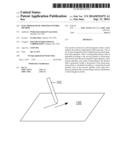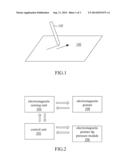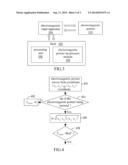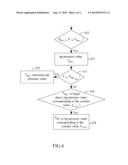Patent application title: Electromagnetic Pointer Control Method
Inventors:
Yen-Hao Han (Hsinchu City, TW)
Assignees:
WALTOP INTERNATIONAL CORPORATION
IPC8 Class: AG06F30354FI
USPC Class:
345173
Class name: Computer graphics processing and selective visual display systems display peripheral interface input device touch panel
Publication date: 2014-09-11
Patent application number: 20140253475
Abstract:
The invention disclosed an electromagnetic pointer control method, the
method comprising the following steps. First of all, an electromagnetic
pointer is applied upon an electromagnetic input apparatus. Then a
corresponding distance table is generated according to the moving
distance of electromagnetic pointer upon the electromagnetic input
apparatus, and a pressure gradient value range corresponding to the
distance table is generated. Finally, a tip pressure of the
electromagnetic pointer is calculated according to a maximum pressure
gradient value in the pressure gradient value range and a pressure
gradient value corresponding to the moving distance of electromagnetic
pointer.Claims:
1. An electromagnetic pointer control method, comprising: providing an
electromagnetic pointer upon an electromagnetic input apparatus;
generating a distance table according to a moving distance of the
electromagnetic pointer upon the electromagnetic input apparatus, and a
pressure gradient value range corresponding to the distance table;
generating a pressure table according to the pressure gradient value
range; and calculating a tip pressure of the electromagnetic pointer
according to a maximum pressure gradient value in the pressure gradient
value range and a pressure gradient value corresponding to the moving
distance of electromagnetic pointer.
2. The electromagnetic pointer control method of claim 1 further comprising a step of applying a counter to moderate an increase of the tip pressure.
3. The electromagnetic pointer control method of claim 2, wherein the counter has a counter value range corresponding to the pressure gradient value range.
4. The electromagnetic pointer control method of claim 1, wherein the electromagnetic input apparatus comprises a digitizer.
5. The electromagnetic pointer control method of claim 1 further comprising a step of determining whether the moving distance is larger than or equal to a distance DMapn corresponding to a pressure gradient value n of a distance table, and whether the moving distance is smaller than or equal to a distance DMapn+1 corresponding to a pressure gradient value n+1 of the distance table.
6. The electromagnetic pointer control method of claim 5, wherein if the moving distance is larger than or equal to DMapn, and the moving distance is smaller than or equal to DMapn+1, then the tip pressure is a tip pressure value PMAPn corresponding to the pressure gradient value n.
7. The electromagnetic pointer control method of claim 1 further comprising a step of determining whether the moving distance is larger than or equal to a distance DMapMaxP corresponding to the maximum tip pressure gradient value of the distance table.
8. The electromagnetic pointer control method of claim 7, wherein if the moving distance is larger than or equal to the distance DMapMaxP, the tip pressure value is determined as a minimum tip pressure value.
9. An electromagnetic pointer control method, comprising: providing an electromagnetic pointer upon an electromagnetic input apparatus; generating a distance table according to a moving distance of the electromagnetic pointer upon the electromagnetic input apparatus, and a pressure gradient value range corresponding to the distance table; generating a pressure table according to the pressure gradient value range; and applying a counter with a counter value range corresponding to the pressure gradient value range; calculating a tip pressure of the electromagnetic pointer according to a maximum pressure gradient value in the pressure gradient value range and a pressure gradient value corresponding to the moving distance of electromagnetic pointer.
10. The electromagnetic pointer control method of claim 9 further comprising a step of determining whether the moving distance is larger than or equal to a distance DMapn corresponding to a pressure gradient value n of a distance table, and whether the moving distance is smaller than or equal to a distance DMapn+1 corresponding to a pressure gradient value n+1 of the distance table.
11. The electromagnetic pointer control method of claim 10, wherein if the moving distance is larger than or equal to DMapn, and the moving distance is smaller than or equal to DMapn+1, then the tip pressure is a tip pressure value PMAPn corresponding to the pressure gradient value n.
12. The electromagnetic pointer control method of claim 9 further comprising a step of determining whether the moving distance is larger than or equal to a distance DMapMaxP corresponding to the maximum tip pressure gradient value of the distance table.
13. The electromagnetic pointer control method of claim 12, wherein if the moving distance is larger than or equal to the distance DMapMaxP, the tip pressure value is determined as a minimum tip pressure value.
Description:
CROSS-REFERENCE TO RELATED APPLICATIONS
[0001] The entire contents of Taiwan Patent Application No. 102107960, filed on Mar. 6, 2013, from which this application claims priority, are incorporated herein by reference.
BACKGROUND OF THE INVENTION
[0002] 1. Field of the Invention
[0003] The present invention generally relates to an electromagnetic pointer control method, and more particularly to an electromagnetic pointer control method which can provide an electromagnetic pointer with a tip pressure-sensitive function.
[0004] 2. Description of Related Art
[0005] The operation principle of electromagnetic type input technology is performed by a circuit board with a plurality of antennas or sensor coils arranged along axial directions and an electromagnetic pen which can emit electromagnetic signals. The sensing plane of an electromagnetic input apparatus includes a plurality of antennas or sensor coils. The antennas or sensor coils are arranged under a work surface or a display panel of the electromagnetic input apparatus. The coordinates of the electromagnetic pen are obtained through the transmitting and receiving of electromagnetic waves between the circuit of the electromagnetic pen and the antennas or the sensor cons.
[0006] The circuit of the electromagnetic pen usually comprises an inductor, a capacitor and relative components enclosed in a case. The inductor constituted by a ferrite core winded with a metal coil and the capacitor constitute the circuit to transmit and receive electromagnetic signals with the antennas or sensor coils. The frequency of the circuit is determined according to the capacitance and the inductance connected in parallel. When a user utilizes the electromagnetic pen to perform writing function on the input apparatus, the tip of the electromagnetic pen being pressed would induce the continuous changes of the inductance or capacitance as well as the frequency of the circuit. The input apparatus detects and calculates the frequency of the electromagnetic signals received to obtain pressure levels of the electromagnetic pen via an internal circuit.
[0007] The main design principle for obtaining pressure gradient value of an electromagnetic pen mentioned above is to continuously change capacitance or inductance so as to alter the transmitting frequency of the oscillation circuit when the pen tip is pressed, so that a trigger structure connected to the pen tip which can change the capacitance or inductance is necessary.
[0008] The invention focuses on an electromagnetic control method which can be used on an electromagnetic pen without a trigger structure connected to the pen tip so that any electromagnetic pen without a trigger structure can have a tip pressure-sensitive function.
SUMMARY OF THE INVENTION
[0009] One object of the invention is to provide an electromagnetic pointer control method. The electromagnetic pointer control method uses the moving speed of an electromagnetic pointer to calculate tip pressure calculation and to simulate the tip pressure gradient value of the electromagnetic pointer. The faster the electromagnetic pointer moves, the smaller the tip pressure of the electromagnetic pointer is simulated. The electromagnetic pointer control method utilizes a distance table, a pressure table and the moving speed of an electromagnetic pointer to calculate and simulate the tip pressure of the electromagnetic pointer.
[0010] The invention provides an electromagnetic pointer control method, the method comprising the following steps. First of all, an electromagnetic pointer is applied upon an electromagnetic input apparatus. Then a corresponding distance table is generated according to the moving distance of electromagnetic pointer upon the electromagnetic input apparatus, and a pressure gradient value range corresponding to the distance table is generated. A counter with a counter value range corresponding to the pressure gradient value range is applied. Finally, a tip pressure of the electromagnetic pointer is calculated according to a maximum pressure gradient value in the pressure gradient value range and a pressure gradient value corresponding to the moving distance of electromagnetic pointer.
BRIEF DESCRIPTION OF THE DRAWINGS
[0011] FIG. 1 shows an electromagnetic pointer and a sensing plane of an electromagnetic input apparatus according to one embodiment of the present invention.
[0012] FIG. 2 shows an electromagnetic input apparatus according to one embodiment of the present invention.
[0013] FIG. 3 shows an input system which applies one embodiment of the invention.
[0014] FIG. 4 shows a flow chart of an electromagnetic pointer control method with a tip pressure-sensitive function according to one embodiment of the present invention.
DETAILED DESCRIPTION
[0015] Embodiment of this invention will be described in detail below. However, in addition to as described below, and this invention can be broadly implemented in the other cases the purpose and scope of this invention is not affected by the application of qualified, claim after its prevail. Furthermore, to provide a description more clear and easier to understand the invention, the pieces within the schema and not in accordance with theft relative size of drawing, compared to certain dimensions to other scales have been exaggerated; details not related nor completely drawn in part in order to schematic simplicity.
[0016] FIG. 1 shows an electromagnetic pointer and a sensing plane of an electromagnetic input apparatus according to one embodiment of the present invention. As shown in FIG. 1, the electromagnetic pointer 102 performing input operation upon the sensing plane 100 of the electromagnetic input apparatus moves from coordinate (x1, y1) to coordinate (x2, y2). In one embodiment of the invention, the electromagnetic pointer 102 comprises, but not limited to an electromagnetic pointer without a trigger structure connected to the pen tip for performing a tip pressure-sensitive function. The electromagnetic pointer is merely an example of one embodiment of the invention, not a limitation. The embodiment of the invention is able to be applied any other suitable electromagnetic pointer.
[0017] FIG. 2 shows an electromagnetic input apparatus according to one embodiment of the present invention. In one embodiment of the invention, the electromagnetic input apparatus comprises a control unit 202, an electromagnetic sensing unit 204 and an electromagnetic pointer tip pressure module 206. The electromagnetic input apparatus comprises, but not limited to a digitizer and an electromagnetic input module of a mobile communication apparatus. The electromagnetic pointer tip pressure module 206 comprises firmware programs and memory storing the firmware programs so as to perform an electromagnetic pointer control method which can provide an electromagnetic pointer 208 with a tip pressure-sensitive function when the electromagnetic pointer 208 is applied upon the sensing plane of the electromagnetic input apparatus to perform input operation. Detail content of the electromagnetic pointer control method for providing an electromagnetic pointer with a tip pressure-sensitive function will be described in the following description.
[0018] FIG. 3 shows an input system which applies one embodiment of the invention. In one embodiment of the invention, the input system comprises a host 302 and an electromagnetic input apparatus 304. The host 302 comprises, but limited to a computer and a mobile communication apparatus. The host 302 comprises a processing unit 306 and an electromagnetic pointer tip pressure module 308. The electromagnetic pointer tip pressure module 308 comprises software programs and computer readable mediums storing the software programs so as to perform an electromagnetic pointer control method which can provide an electromagnetic pointer with a tip pressure-sensitive function when the electromagnetic pointer is applied upon the sensing plane of the electromagnetic input apparatus 304 to perform input operation. The computer readable medium stores executable codes or programs for the processing unit 306. The computer readable medium comprises storage mediums such as a hard drive, a memory, etc.
[0019] In one embodiment of the invention, the electromagnetic pointer control method with a tip pressure-sensitive function uses a distance table and a pressure table to transform the moving distance of an electromagnetic pointer to a tip pressure of the electromagnetic pointer. The electromagnetic pointer control method also uses a counter to moderate the increase of the tip pressure of the electromagnetic pointer and to prevent the initial tip pressure from being too large.
[0020] If the electromagnetic pointer shown in FIG. 1 moves from coordinate (x1, y1) to coordinate (x2, y2), the distance table is established according to the following:
D= {square root over ((x2-x1)2+(y2-y1)2)}{square root over ((x2-x1)2+(y2-y1)2)}
DMapn=n+1
n=0,1,2, . . . ,MaxP
[0021] wherein DMapn is the moving distance of the electromagnetic pointer corresponding to pressure gradient value n in the distance table, 0, 1, 2, . . . , MaxP is the range of pressure gradient value.
[0022] In one embodiment of the invention, the tip pressure in the pressure table is calculated according to the following equation:
P MAP n = MaxP × ( MaxP - n MaxP ) γ + 0.5 ##EQU00001## n = 0 , 1 , 2 , , MaxP ##EQU00001.2##
[0023] wherein PMAPn is the tip pressure in the pressure table, n is the pressure gradient value in the pressure table and the distance table in a predetermined moving distance, 0, 1, 2 . . . , MaxP is the range of pressure gradient value, MaxP is the maximum pressure gradient value corresponding to the maximum tip pressure. If the number of the pressure gradient values is 1024,
n=0,1,2, . . . ,1023
MaxP=1023
if n=MaxP,
PMapn=PMax
[0024] wherein PMax is the maximum tip pressure. γ is the pressure curve value which is determined according to requirement. The pressure curve is a line or linear if γ=1, and the tip pressure variation of the electromagnetic pointer is linear. The value 0.5 is used to round off.
[0025] In one embodiment of the invention, the counter value Pcount is used to moderate the increase of the tip pressure of the electromagnetic pointer and to avoid the sudden increase of the tip pressure or the excess of the tip pressure over the predetermined pressure gradient value range.
PCount=0,1,2, . . . ,MaxP
[0026] If the initial tip pressure is too large, the counter value PCount is used to moderate the increase of the tip pressure of the electromagnetic pointer.
[0027] FIG. 4 shows a flow chart of an electromagnetic pointer control method with a tip pressure-sensitive function according to one embodiment of the present invention. As shown in FIG. 4, an electromagnetic pointer moves from coordinate (x1, y1) to coordinate (x2, y2) in step 402. Then in step 404, whether a tip of the electromagnetic pointer is pressed against a sensing plane of an electromagnetic input apparatus is determined. If the tip of the electromagnetic pointer is not pressed against the sensing plane of the electromagnetic input apparatus, then a counter value is determined as zero in step 405, that is, PCount=0. If the tip of the electromagnetic pointer is pressed against the sensing plane of the electromagnetic input apparatus, then a moving distance D of the electromagnetic pointer is calculated in step 406, wherein
D= {square root over ((x2-x1)2+(y2-y1)2)}{square root over ((x2-x1)2+(y2-y1)2)}.
Next in step 408, the counter value PCount is compared to a maximum pressure gradient value MaxP corresponding to a maximum tip pressure to determine whether the counter value PCount is smaller than the maximum pressure gradient value MaxP. If the counter value PCount is smaller than the maximum pressure gradient value MaxP, then the counter value PCount is increased as the electromagnetic pointer moves. Then in step 410, whether the moving distance D is larger than or equal to a distance DMapn corresponding to a pressure gradient value n of a distance table, and whether the moving distance D is smaller than or equal to a distance DMapn+1 corresponding to a pressure gradient value n+1 of the distance table is determined. If the moving distance D is larger than or equal to DMapn, and the moving distance D is smaller than or equal to DMapn+1, then a tip pressure value PMAPn is determined in step 412. Next in step 414, whether the moving distance D is larger than or equal to a distance DMapMaxP corresponding to the maximum tip pressure gradient value MaxP of the distance table is determined. If the moving distance D is larger than or equal to the distance DMapMaxP, then the tip pressure value PMAPn is determined as a minimum tip pressure value in step 415. If the moving distance D is not larger than or not equal to the distance DMapMaxP, then whether the tip pressure value PMAPn is larger than a tip pressure value corresponding to the counter value PCount is determined in step 416. If the tip pressure value PMAPn is larger than the tip pressure value corresponding to the counter value PCount, then the tip pressure value PMAPn is determined or reset as the tip pressure value corresponding to the counter value PCount in step 418. That is, whenever the tip pressure value PMAPn is larger than the tip pressure value of the predetermined pressure table, in order to moderate the increase of the tip pressure, the tip pressure value PMAPn is set as the tip pressure value corresponding to the counter value PCount.
[0028] The embodiments of the invention can be applied on various electromagnetic pointers to perform various functions. Whether electromagnetic pointers are used to perform the embodiments of the invention depends on the requirements.
[0029] The electromagnetic pointer control method of the invention uses the moving speed of an electromagnetic pointer to calculate tip pressure calculation and to simulate the tip pressure gradient value of the electromagnetic pointer. The faster the electromagnetic pointer moves, the smaller the tip pressure of the electromagnetic pointer is simulated. The electromagnetic pointer control method utilizes a distance table, a pressure table and the moving speed of an electromagnetic pointer to calculate and simulate the tip pressure of the electromagnetic pointer. Moreover, the moderate increase counter values of a counter are used to moderate the increase of the tip pressure values. The moving distance of an electromagnetic pointer are converted to the tip pressure values thereof, or the signals of the coordinate movement of the electromagnetic pointer are transformed to tip pressure gradient value signals through firmware or software programs according to the embodiments of the invention. The electromagnetic pointer control method enables users to perform various functions of an electromagnetic pointer when the electromagnetic pointer is applied on electromagnetic input apparatus or system.
[0030] Although specific embodiments of the present invention have been described, it will be understood by those of skill in the art that there are other embodiments that are equivalent to the described embodiments. Accordingly, it is to be understood that the invention is not to be limited by the specific illustrated embodiments, but only by the scope of the appended claims.
User Contributions:
Comment about this patent or add new information about this topic:
| People who visited this patent also read: | |
| Patent application number | Title |
|---|---|
| 20210402265 | MULTI-MATERIAL IRON GOLF CLUB HEAD |
| 20210402264 | GOLF CLUB HEAD AND METHOD OF MANUFACTURING THE SAME |
| 20210402263 | Stitchless Sportsball and Manufacturing Method Thereof |
| 20210402262 | GOLF BALLS HAVING LAYERS MADE OF SILICONE ELASTOMERS |
| 20210402261 | GOLF BALL HAVING A SPHERICAL SURFACE IN WHICH A PLURALITY OF COMBINATION DIMPLES ARE FORMED |




